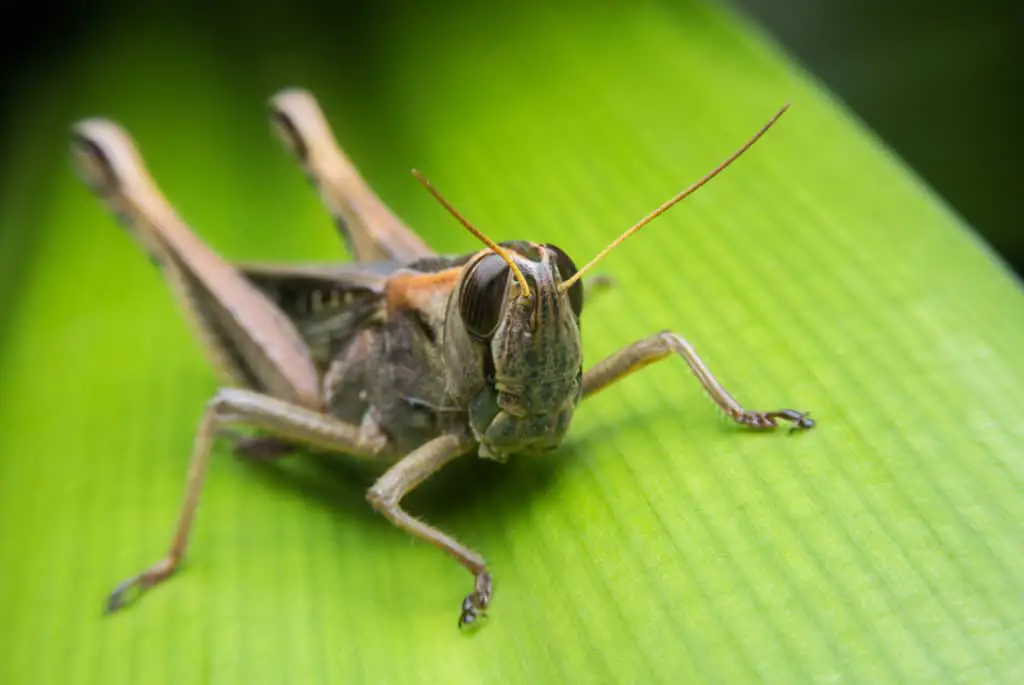Grasshoppers are fascinating creatures, we know they have some insect superpowers like powerful hind legs and a hard armor-like exoskeleton for protection, but what about their ears?
How do grasshoppers hear, and how do they sense their surroundings?
Do grasshoppers have ears? Grasshoppers don’t have ears as we do. Their “hearing” organ is internal, not in their head, but on either side of their abdomen. The organ is the tympanum, it picks up vibrations from the environment. The vibrations are converted to “readable” messages via sensory nerves connecting to the brain.
The following article will take a deeper look into the auditory organs of a grasshopper, how this adaption of hearing benefits them, and some interesting myths surrounding how grasshoppers hear.
A Brief Overlook At The Grasshopper Anatomy
In order to better understand how a grasshopper hears, at least a basic understanding of its anatomy is important.
Grasshoppers fall into the order of Orthoptera, which also includes crickets and katydids.
These insects grow to an average of 2 to 8cm in size (1 to 3 inches), although there are some larger species.
Their bodies, like most insects, are segmented into three main parts. The head, thorax, and abdomen.
They have a pair of antennae, six legs in total, four of which are short and towards the front, and two powerful and large hind legs which are used for jumping.
It is at the base of these muscular hind legs that the hearing organ (tympanum) is found. More specifically the tympanum is located at either side of the first segment of the abdomen.
Did you know that most adult grasshoppers have wings? If you are interested we have a whole article on how grasshoppers fly. You might be surprised how long some grasshoppers can fly. This is the article, Can Grasshoppers Fly?
How Do Grasshoppers Hear?
As mentioned above, grasshoppers do not have external ears like humans. Instead, they have large membranes at the base of their hind legs.
These membranes, called tympanum are the most common means of hearing by insects, although some may use echolocation, or make use of cilia like the sensory hairs along their body, as is with bees.
The Auditory Organ Of A Grasshopper (Tympanate Ear)
These tympanate ears are also known as pressure detectors and have been found in various places on insect bodies, however, on a grasshopper, they are always found at the base of the hind legs.
The tympanate ear consists of three anatomical and functional parts:
- The tympanum
- The tracheal sac
- The tympanal organ.
1. The Tympanum
The tympanum is an area of a thin cuticle that vibrates in correlation with the change of pressure between the internal and external sides.
This membrane is typically round or oval in shape and is surrounded by a thin membrane that isolates the tympanum from the movements and vibrations of the grasshopper’s body.
2. The Tracheal Sac
For animals that hear sound through air vibrations, such as mammals, the membrane (eardrum) will have little significance in picking up vibrations unless there is a density balancing factor inside the ear.
This is known in humans as the inner ear.
In grasshoppers, the tracheal sac performs the same function. The tracheal sac is a pocket of air space or an enlarged trachea that is tightly positioned to the inner side of the tympanum membrane.
3. The Tympanal Organ (Muller’s Organ)
The Muller’s Organ forms a similar function to the Johnston’s Organ in bees and wasps.
The tympanal organ contains a group of sensilla which are called scolopophre. These sensilla receive the vibrations sent from the tympanum membrane and relay the message through sensory nerves to the brain.
In short, external vibrations from the air vibrate the tympanum, the sound is balanced by the tracheal sac and then relayed via the tympana organ, which is then transferred as a “readable” message through sensory nerves to the brain.
What Other Ways Do Grasshoppers Sense Their Surrounding?
Sensing sound vibrations through their “ears” is not the only way grasshoppers register what is going on in the environment around them.

They have multiple sensory organs scattered around the body which include:
- Antennae: The antennae of a grasshopper function much the same as those of other insects. They are responsible for perceiving odor, touch, humidity, wind velocity, and direction.
- Compound Eyes: Grasshoppers have two faceted eyes made up of hexagonal lenses. Although they do not see in the same way as humans, the grasshopper’s sight is attributed to these compounded eyes.
- Palps: Playing a similar role to the human and other mammal’s lips and tongue, the palps are responsible for sensing the texture of food, and registering taste.
The sensory hairs along the palps allow for them to register texture, while the chemoreceptors chemically understand “taste”.
- Cerci: Located on the abdomen, the cerci (cercus for singular) is a sensory appendage. The function of cerci differ but are known to be high in sensory organs and possibly guide copulation and oviposition.
If you are interested we have a whole article on the lifecycle of the grasshopper where you can see the changes in the anatomy of the grasshopper from nymph to adult grasshopper. This is the article, The Lifecycle Of Grasshoppers.
What Are The Advantages Of A Grasshopper’s Hearing Organs?
The evolution of the grasshopper’s extremely sensitive tympanate ear is one of its greatest survival advantages.

These ears play a large role in sensing the location of predators. Grasshoppers are extremely susceptible to larger animals, and only 20% of hatched nymphs will make it to the adult stage.
Because of this, it is of utmost importance that they are well in tune with their environment.
Besides the protection from the prey, grasshoppers’ ears are used for locating a mate.
Male grasshoppers create a mating call that is heard by the female. Because the tympanate ear is so sensitive, the female can easily locate the calling male.

This is once again essential for the species survival.
What Are The Disadvantages Of A Grasshopper’s Hearing Organs?
Although this method of hearing is highly advanced, however, there are a few disadvantages.
Grasshoppers cannot distinguish between pitches very well.
This does not pose too much of a problem when concerned with mating communication, however, because they are more sensitive to higher frequencies, there may be a lack of recognition of their vicinity to predators.
Because, just like the human ear, the membranes of grasshopper ears are incredibly thin, there is a high chance of them being damaged.
If a grasshopper loses its sense of hearing, it is at a massive disadvantage, and therefore will not be able to find a mate, as well as be prone to its predators attack.
Myths And Misconceptions About How Grasshoppers Hear
When we think about grasshoppers we think about their powerful jump and the sweet song that they sing with their legs. However, there are some misconceptions about these songs and the way they hear.
As mentioned above, grasshoppers do not distinguish between frequencies very well.
They do not hear in the same way that we do.
Because of this, the “song” that they sing does not appear the same way to the female grasshopper as it does to our ears.
When grasshoppers make a noise with their hind legs, it comes across as more monotonal to their counterparts instead of a beautiful sounding melody.
Another common misconception is that grasshoppers’ ears are on their legs.
Although there are multiple sensors on the hind legs of a grasshopper, their ears. As mentioned previously, is actually located on the abdomen.
This misconception arises because the exact location of these ears is at the base of the legs, but not actually connected to them.
The Wrap Up
Grasshoppers do not hear the same way that humans and other mammals do, nor do they have ears that protrude from the body like ours.
Although they do have ear-like organs at the base of their hind legs, they register pitch and sound uniquely.
These “sound flaps” are flush with the shell and do not look like ears. They are known as tympanum and function similarly to the membrane inside the human eardrums.
The grasshopper’s auditory sensors are highly adapted and sensitive, which gives it an advantage when staying safe from predators, as well as locating and communicating with mates.
Sources
https://www.ndsu.edu/ndmoths/hopper/anatomy.htm
